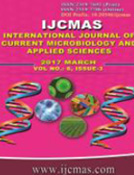


 National Academy of Agricultural Sciences (NAAS)
National Academy of Agricultural Sciences (NAAS)

|
PRINT ISSN : 2319-7692
Online ISSN : 2319-7706 Issues : 12 per year Publisher : Excellent Publishers Email : editorijcmas@gmail.com / submit@ijcmas.com Editor-in-chief: Dr.M.Prakash Index Copernicus ICV 2018: 95.39 NAAS RATING 2020: 5.38 |
Surgical site infections pose a major threat to the morbidity of immunosuppressed patients. They lead to increased hospital stay, delayed recovery, increased treatment cost and a high risk of spread of Nosocomial infections. The present study was conducted to identify the post-operative wound infection rate, to isolate and identify the bacterial pathogens and to determine its antibiotic susceptibility pattern. Total 70 pus samples were collected from patients having post-operative wound infections out of 716 operations performed during January to December, 2016. Samples were processed as per standard guidelines. Out of 70 pus samples, 57 yielded growths of organisms making total 59 isolates. Out of 59 bacterial isolates most common isolate was Staphylococcus aureus 13(22.03%) followed by E. coli and Acinetobacter spp.12 (20.33%) each and Pseudomonas aeruginosa 10 (16.94%), & Klebsiella spp 08(13.55%). Out of 44 GNB, 27 (61.36%) were Extended Spectrum β lactamase (ESBL) producer. Out of 13 S. aureus, 04 (30.76%) were Methicillin Resistant Staphylococcus aureus (MRSA) sensitive to Vancomycin. Post-operative wound infection rate was 9.77%. Most isolates were multi drug resistance. Changing antimicrobial resistance pose challenge in treating pyogenic infections. Appropriate and judicious selection of antibiotic would limit the emerging drug resistant strains in the future to treat these clinical conditions successfully.
 |
 |
 |
 |
 |